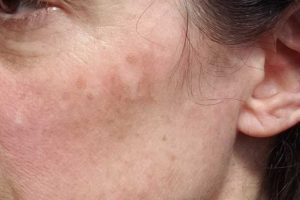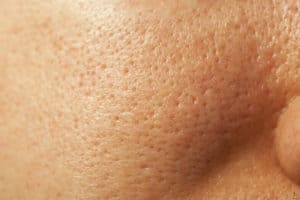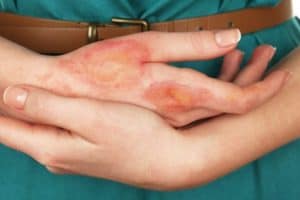Skin peeling is common on many parts of the body, including the bottom of the feet. Your feet are used to wear and tear. But if there is peeling on your feet that just won’t go away, there could be an underlying problem, which you need to determine. What causes peeling at the bottom of your feet?
The most common reasons for skin peeling off the bottom of feet are dry skin, hyperhidrosis, psoriasis, athlete’s foot, and eczema.
Over-the-counter medications are often effective in treating mild cases of peeling at the bottom of your feet.
If the peeling does not improve and you feel that additional symptoms are cropping up, you need to consult a dermatologist or doctor.
Some mild, thick skin peeling at the bottom of the feet is quite common for all people. Your habits and physical activities usually give rise to this skin condition. But there are cases wherein bottom feet peeling is due to certain skin conditions or illnesses, which only skin specialists can identify.
Read on to learn more about skin peeling off the bottom of feet as well as how to treat this skin issue.
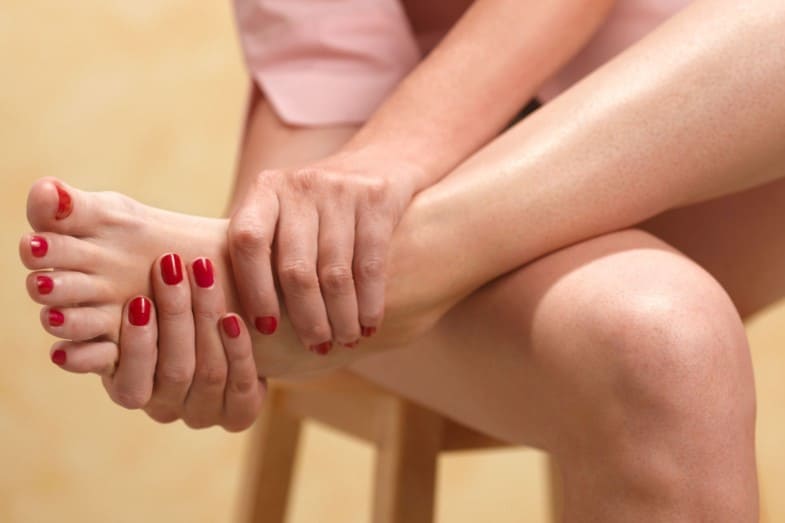
Bottom of Feet Peeling
Skin peeling off the bottom of feet is commonly caused by dry skin, hyperhidrosis, psoriasis, athlete’s foot, or eczema.
Your skin, including the soles of your feet, protect you from harmful elements.
Natural exfoliation and regeneration of the skin at the bottom of the feet often happen, resulting in the thickening of the skin’s outer layer. Itching and skin peeling off the bottom of your feet can also occur when the skin is naturally exfoliating itself.
It’s also common for skin peeling to occur and not have itchy skin or any signs of a skin issue.
Below are various causes for bottom of feet peeling.
1. Environmental Causes
Peeling skin on the bottom of feet may occur due to environmental factors.
Physical Environmental Conditions: All physical environmental conditions such as humidity, sun, wind, cold, and heat can cause skin peeling as a reaction. If you overexpose your skin to the sun’s rays, you may experience excessive dryness in your skin, which can lead to skin peeling. Even the bottom of your feet needs sunscreen protection.
Lack of Air Moisture: This factor can also cause skin dryness that leads to skin peeling. In other words, any kind of exposure to extreme temperatures, whether hot or cold, can lead to skin peeling.
2. Personal Habits
Trauma: If your feet are constantly subjected to physical activity, the skin at the bottom of your feet is going to be irritated. So any kind of skin trauma at the bottom of your feet can lead to peeling.
Wearing Shoes for Long Periods: This habit can also cause peeling at the bottom of your feet. Your feet will sweat and make your feet damp. When you wear shoes for longer durations, dead skin cells will accumulate, leading to the cracking and peeling of thick skin.
Other bad personal habits include wearing ill-fitting shoes and using bath soaps or detergents with harsh chemicals.
3. Fungal Infection
When your feet are exposed to excessive dampness, a fungal infection could develop. You can also get fungal infections from infected individuals or contaminated places.
Initially, the symptoms could manifest as itching and peeling of the skin around the toes. But if it becomes a chronic fungal infection, skin peeling could spread all over the feet, including the sole.
One fungal infection that can lead to the bottom of feet peeling is athlete’s foot. The symptoms may include itching, burning, redness, blisters, softening of the skin, cracking, scaling, and of course, skin peeling.
There are three types of athlete’s foot. One type is vesicular, the other type is interdigital, and the last type is moccasin. It is the moccasin type of athlete’s foot that typically leads to the peeling of thick skin at the sole of the feet.
4. Normal Bodily Functions
Your body is designed to shed off skin naturally. However, the skin at the bottom of your feet typically builds up. Eventually, it gets thick and will most likely peel off. Some of your skin cells die each day.
Daily bathing and washing can help remove dead skin cells. If you forget to scrub the sole of your feet once in a while, dead skin cells will accumulate. These dead skin cells will get flaky and peel off eventually.
5. Allergies
If you are allergic to certain substances, food, fragrances, and cosmetics, your feet will be one part of your body that will manifest the symptoms. Skin peeling at the soles of your feet could be one of the symptoms of an allergy.
6. Systemic Causes
There are underlying systemic causes that can trigger the peeling of skin at the bottom of your feet. These systemic causes include:
Genes: Hereditary conditions can lead to foot skin peeling. These conditions often go undiagnosed since the symptoms are not that serious and are similar to other usual skin conditions.
Cancer: Although rare, foot skin peeling can be caused by cancer, including different cancer treatments.
7. Inflammatory Causes
Peeling on the soles of the feet can also be triggered by bacterial infections. Wounds or cuts on the soles of the feet should be cleaned and dressed regularly to prevent any infection.
8. Dermatitis
Lack of skin proteins usually leads to dermatitis. This skin condition will also make the skin hypersensitive to certain substances in the environment. It is a chronic skin condition characterized by itching, swelling, redness, and peeling of the skin. The bottom of your feet can also develop dermatitis.
9. Reiter’s Syndrome
Reiter’s syndrome, also known as reactive arthritis, can develop as a response of the immune system to certain infections. This condition causes inflammation in the urinary tract, eyes, joints, and skin. This syndrome can also cause skin peeling on the palms of hands and soles of the feet.
10. Fever and Excessive Sweating
Fever can dehydrate the skin. There’s a loss of fluid in your body if you have a fever. Loss of fluid can happen through the skin to help bring down high body temperature. In some cases, fever can cause excessive sweating that leads to dehydration, particularly if lost fluids aren’t replenished.
Sweating on the feet will also accumulate underneath the skin, causing the formation of small blisters. These blisters will burst and eventually lead to skin peeling.
Bottom of Feet Peeling: Non-itchy Causes
Physical factors can cause non-itchy peeling at the bottom of the feet. When you don’t take off your shoes most of the day, your feet will sweat and get damp and moist. To dry your feet, expose them outside, in the open air.
If you regularly repeat the cycle of dampness and dryness, your skin will crack and start to peel off. However, it will not feel itchy. To prevent this skin condition, give enough time for your feet to breathe by not wearing footwear all day long.
Another factor that can cause non-itchy skin peeling at the bottom of your feet is dry skin. Bacterial or fungal infection can cause skin dryness because of poor ventilation inside your shoes. So, let your feet breathe from time to time to avoid infection and other irritating skin conditions.
Treatments for Skin Peeling Off the Bottom of Feet
Whatever the cause of feet skin peeling, many home remedies can effectively get rid of the condition. Here are some of the home treatments that you can do to get your feet back to normal.
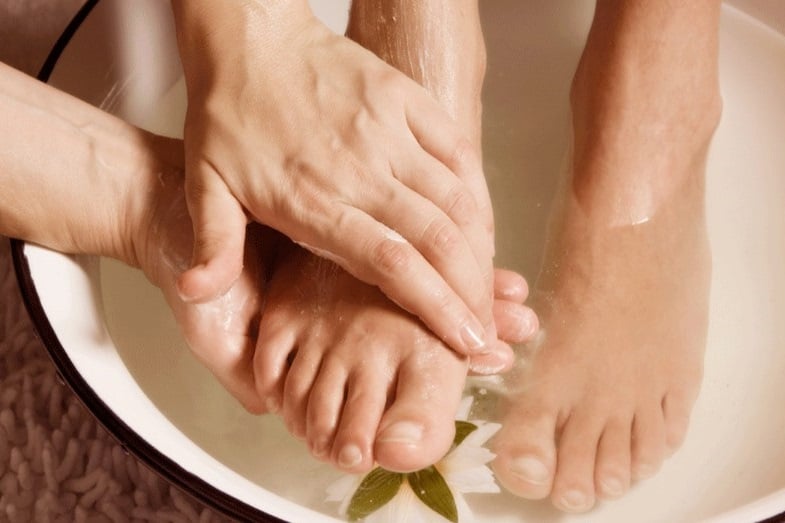
1. Soak Your Feet in Warm Water
Warm water can relax your feet. Dipping your feet into a bowl of warm water will loosen dead skin cells, which cause your feet to dry up.
Here’s what you need to do:
- Pour warm water in a metal bucket that can accommodate your feet.
- Place your feet inside the bucket for around 30 minutes.
- Get your feet out of the bucket and scrub off the dead cells.
- Dry your feet.
- Moisturize your feet by applying a moisturizing lotion.
2. Use Epsom Salt
Epsom salt can help improve the circulation of blood around your feet. Proper blood flow helps in the elimination of dead skin cells. Additionally, there are small amounts of magnesium in Epsom salt that can remove toxins from the feet.
Here’s what you need to do:
- Put some Epsom salt in a bucket of water.
- Soak your feet in the water for around 10 minutes.
- Pull your feet out and scrub off the dead cells.
- Dry your feet and apply sufficient amounts of petroleum jelly.
- Repeat this procedure for three days until the condition of your skin improves.
3. Use Oatmeal
Oatmeal is an effective agent that can help get rid of dead skin cells on the soles of your feet. You can use an oatmeal paste as an effective moisturizer or scrub for the bottom of your feet to help stop the skin peeling.
Here’s how you can use this everyday product:
- Mix a reasonable amount of oatmeal with some milk or rose water.
- Apply the mixture on the soles of your feet and let it stay there for around 45 minutes.
- Scrub the soles of your feet by using a foot brush.
- Get some cold water and rinse your feet. Pat dry.
- Repeat this process every other day until the skin peels less and less.
4. Use Mentholated Rub
A mentholated rub is also helpful in treating dry and cracked feet. Most mentholated rubs contain essential oils. They are also effective in fighting off fungal infections.
Here is how to use this product for skin peeling:
- Wash, clean, and dry your feet.
- Apply mentholated rub on your feet.
- Put on your socks and leave them overnight.
- Upon waking up in the morning, wash your feet with warm water.
- Repeat the process until you see improvements.
5. Use Vinegar
Vinegar is another everyday product that can effectively treat skin peeling at the bottom of your feet. It can soften dead skin cells and encourage the development of smoother skin.
Here’s how to use it:
- Mix vinegar with water and put the mixture in a bucket.
- Soak your feet on the mixture for around 20 minutes.
- Scrub off the dead skin cells.
- Wash and dry your feet.
- Apply petroleum jelly on your feet.
- Repeat the process until you see improvements.
Treat the Underlying Cause
To get rid of peeling at the bottom of your feet, you’ll need to find out and treat the underlying cause. The best way to do it is to see a dermatologist. Skin specialists can diagnose the problem and recommend effective treatments correctly.
- If the underlying cause is a fungal infection, the doctor will recommend an effective fungal cream.
- If the condition is due to reactive arthritis, doctors will likely prescribe a topical steroid cream and/or nonsteroidal anti-inflammatory drugs.
- If allergies cause the problem, doctors will recommend taking antihistamines and avoidance of allergens.
- If the underlying cause is dermatitis, your doctor will prescribe treatment according to the severity of your skin problem. He or she may also recommend the application of a steroid cream.
Conclusion – Bottom of Feet Peeling: Causes and Treatments
So to recap, if you are experiencing bottom of feet peeling, perhaps thick skin peeling, whether itchy or not itchy, there are many possible causes and treatments. The most common causes are dry skin, hyperhidrosis, athlete’s foot, and many more.
Over-the-counter medications can treat mild cases of skin peeling. But if the peeling of thick skin does not improve and you feel that additional symptoms are cropping up, you have to seek the help of a dermatologist.
Related reading:
Armpit Skin Peeling: Causes and Treatments
How Long Does Skin Peel After a Sunburn?

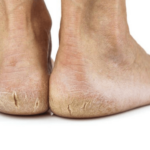
![Bleeding Pore on Nose [11 Possible Causes and Treatments] bleeding pore on nose](https://skincaregeeks.com/wp-content/uploads/2021/04/bleeding-pore-on-nose-150x150.jpg)
![Bruise Itches [Causes and Treatments for an Itchy Bruise] bruise itches](https://skincaregeeks.com/wp-content/uploads/2021/04/bruise-itches-150x150.jpg)
